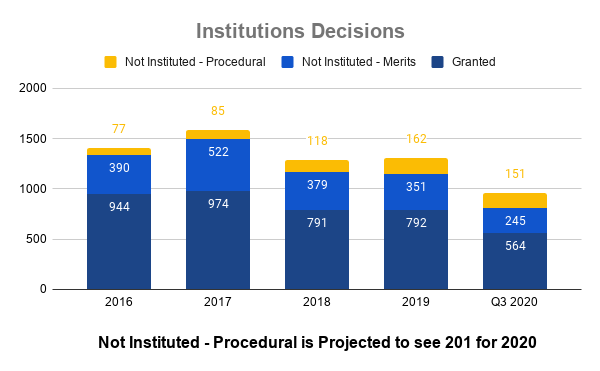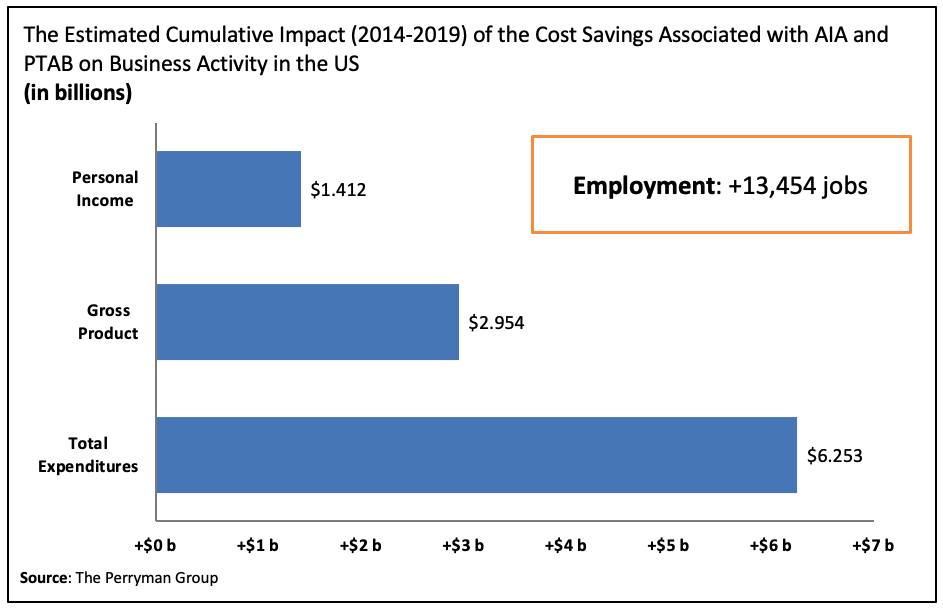Key Takeaways: After returning to the data, breaking down all discretionary denials by category, and updating the data for the past three months, it is clear that the PTAB now prefers denying more petitions under their recent NHK Spring/Fintiv “parallel district court” practice than any other means; discretionary denials as a percentage of overall denials have risen and will almost certainly exceed last year’s denials, both in terms of raw numbers (in a down year) and by overall percentage (by a substantial margin).
Following Unified’s Quarter 1 and Quarter 2 reports on PTAB procedural denials, we went back to further analyze and categorize all Board decisions to date to understand the impact of new decisions, including the NHK Spring/Fintiv and General Plastic/NVIDIA line of decisions. This year, the number of non-merits or “procedural” denials by the Board has dramatically increased overall; for example, through the first nine months of 2020, 151 denials (16% of all decisions) have been issued, nearly tying 2019’s 162 denials for the entire year.
With total number of institution decisions by the Board somewhat depressed overall this year, we now see that the amount of discretionary denials as a percentage of total denials has risen dramatically, representing more than a third of all institution denials in 2020–or put another way, 38% of all denials in 2020 to date are cases where the Board did not consider the merits of the petition.
In the 151 denials to date in 2020, 314(a) has been the predominant means of procedural denial, used by the PTAB 73% of time (110 total decisions). Meanwhile, 325(d) denials are at their lowest since 2017, with only 27 denials this year. This year has also not seen any “combination” denials under both 314(a) and 325(d).
The reduction in 325(d) denials makes sense on some level, given the overlap between the various 314 analyses (which include analyses of other petitions or forums and the grounds they raised), and with the overlap of the “same or substantially same” grounds already raised by the parties in other IPR proceedings. In those overlapping instances, 314 may be an easier form of denial, whereas application of 325 may be less straightforward, requiring a more prior art-heavy analysis to justify denial.
Looking at the last five years, 314(a) denials are now used by the Board 9.5% of time, up 2.5% from the last quarter.
On the other hand, while § 325(d) denials are at their lowest overall number since 2017 (so far), they have decreased just .3% from the last quarter, to 5.4% total over the past five years as a percentage of all denials.
In 2020 to date, 83% of all procedural denials are denied due to either a parallel petition, the NHK Spring/Fintiv framework, or the General Plastic/NVIDIA framework. Parallel petitions accounted for 40% of (or 44) denials of the 110. NHK Spring/Fintiv framework was used 43% of the time to deny petitions (or 47 denials of the 110 total). Interestingly given that it was the genesis of “discretionary denials” under 314, the General Plastic/NVIDIA framework was used just 13% of the time (or in 14 denials of the 110).
One of the more interesting developments in the analysis used in NHK Spring/Fintiv denials has been the denial of institution based on the Board “estimating” when a trial will be held, even when a trial date has not been scheduled in the District Court. In two recent cases, the Board refused to consider the merits of challenges based on their own estimates of when a trial date was likely to occur, and rejected arguments and speculations to the contrary.
There has also been a notable reliance on the “cost” and “investment” of the PTAB, the parties, and the Court in their respective proceedings, or the cost or benefit of such respective proceedings, without any substantive economic analysis of actual economic cost to any party or institution, or a reliance on any data whatsoever to support a cost (or benefit) to the parties or decision makers. The lack of any economic support for economic assumptions made by the agency is notable, given that economic efficiency is one of the primary grounds advanced by the agency on which such denials are based.
For questions, comments, or inquiries, please contact info@unifiedpatents.com
Click to download the full report.
Footnotes
PTAB/District Court Trial Date Denials Spiraling Upward: Discretionary PTAB Denials Third-Quarter Report by Unified Patents, LLC is licensed under a Creative Commons Attribution 4.0 International License. Sharing, reproduction, and adaptation are permitted in commercial contexts with proper attribution.
Unified Patents, PTAB Procedural Denials and the Rise of § 314 (May 13, 2020), https://www.unifiedpatents.com/insights/2020/5/13/ptab-procedural-denial-and-the-rise-of-314.
Unified Patents, PTAB Discretionary Denials: In the First Half of 2020, Denials Already Exceed All of 2019 (July 27, 2020), https://www.unifiedpatents.com/insights/2020/7/27/ptab-discretionary-denials-in-the-first-half-of-2020-denials-already-exceed-all-of-2019.
We refer to “procedural denials” as any denial of institution where the substantive merits of the petition were not considered in light of policy-based decision making or “discretion.” Some discretion is directly spelled out in the statute–for instance, 35 U.S.C. 325(d) tightly circumscribes and explicitly grants the Director the ability to “determine the manner in which the post-grant review or other proceeding or matter may proceed, including providing for the stay, transfer, consolidation, or termination of any such matter or proceeding.” Joinder discretion is made explicit under 35 U.S.C. 315(c): “the Director, in his or her discretion, may join as a party to that inter partes review any person who properly files a petition ... that the Director ... determines warrants the institution of an inter partes review under section 314.” Meanwhile, 35 U.S.C. 314(a) contains no such express grant or outline.
NHK Spring Co. v. Intri-Plex Technologies, Inc., IPR2018-00752, Paper 8 (PTAB Sept. 12, 2018) (precedential); Apple Inc. v. Fintiv, Inc., IPR2020-00019, Paper 11 (PTAB Mar. 20, 2020) (precedential).
General Plastic Industrial Co., Ltd. v. Canon Kabushiki Kaisha, IPR2016-01357, Paper 19 (PTAB Sept. 6, 2017) (precedential); NVIDIA Corp. v. Samsung Elec. Co., IPR2016-00134, Paper 9 (PTAB May 4, 2016).
For the sake of simplicity and because it was more difficult to code for and not explicitly tied to a particular precedential decision, we placed the July 2019 Trial Practice Guide Update line of cases (i.e., the “parallel petition” denials based on ranking of petitions) with the General Plastics/NVIDIA line of cases. We will continue to refine the data to provide the most accurate picture possible as we produce future reports. If you have inquiries about methodology or the data or reports themselves, please contact PatentQualityInitative@unifiedpatents.com.
The remaining 5 denials amounted to another 4.5% of all denials, for various reasons.
Intel Corp. v. VLSI Technology, LLC, IPR2020-00583, Paper 22 (PTAB Oct. 5, 2020); Supercell Oy v. GREE, Inc., PGR2020-00053, Paper 12 (PTAB Oct. 9, 2020).
Copyright © 2020, Unified Patents, LLC. All rights reserved.






















